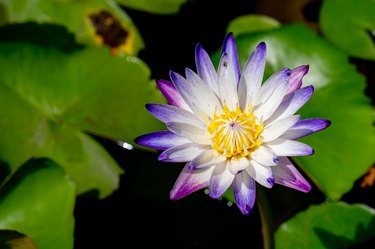
Along with the ability to grow 19-foot-tall stems in their watery habitat, lotus plants (Nelumbo nucifera) also have huge leaves and flowers that expand to 24-inch and 12-inch diameters, respectively. This perennial's flowers tend to bloom in the summer in U.S. Department of Agriculture plant hardiness zones 4 through 11. The blooms employ several strategies to increase success of lotus flower reproduction.
Summer Blooming Period
Video of the Day
Lotus plants take advantage of the warm summer days, and subsequent breezes, to create an intoxicating fragrance and visual display for successful lotus flower pollination. For approximately two weeks, sometime between July and September, the lotus flower stalk continually grows at night until the flower is ready to open. The resulting, cup-shaped flower is typically white or pink -- its strategic shape provides a resting spot for pollinating insects as they fly across the water. Although the budding period takes several weeks, the actual flower bloom time is a short three-day period as the blossoms only remain open during daytime hours.
Video of the Day
Self-Pollinating Lotus Flowers

After growing to a mature length of seven stem sections, your lotus plant has the ability to form bisexual, or perfect, flowers. Containing both male and female reproductive parts, lotus flowers have the ability to self-pollinate. As pollen grains rub off from the stamens and onto the centralized stigma, a tube forms down to the flower's ovule where it becomes fertilized. Because of the flowers' isolated position on the water, wind gusts often help the blossoms become pollinated. Afterward, the flower begins to die back while retaining the fertilized ovule at the bud's center. Thus the lotus flower reproduction succeeds.
Beneficial Insect Activity
Warm summer conditions entice insects to travel throughout their environment in search of nectar -- cold, rainy days typically deter insects from moving about. For example, honeybees use both scent and good eyesight to find nearby flowers as the sun shines on the bright lotus sitting in a water environment. As the insect lands and rubs on the blossom, pollen grains may fertilize the same flower and adhere to the insect's body. Moving between different lotus flowers, insects slowly cross-pollinate the area as the pollen falls off of their bodies. As a result, the lotus diversifies its genetic map with pollen from another plant. This process increases species resilience and strength as it evolves over time.
While not as well-known as the carnivorous Venus flytrap, lotus flowers use their own style of entrapment -- but for the sake of pollination, not nourishment. The most commonly caught bugs are beetles, which the flower traps when it closes. The lotus usually allows the bug to escape by opening the following day -- after it spends the night performing its pollination duties.
Hand Pollinating Lotus Flowers

If you want to have your own miniature lotus garden, it is possible to grow these plants in a large tub, along with pond mud covering the bottom for plant sustenance. With blossoms within arm's reach, you can hand-pollinate the lotus by using a small brush. Carefully swipe the stamen and transfer the grains to the blossom's center stigma. Simulate cross-pollination by moving between different plants for the best lotus flower reproduction results.